新人教版高中英语必修3Unit 2 Morals and Virtues教学设计四
-
- 页数:5页
- 字数:约 6798 字
- 大小:688.22KB
- 格式:.docx
- 版本:Office2016及以上版本
- 作者:wuwei-ppter
Unit 2 Morals and Virtues教学设计
Period 4 Readingfor writing
该板块的活动主题是“分享关于一个道德故事的看法”( Share your opinions about a moralstory)。前面的 Listening and Talking板块重点讨论人的日常行为与为人处世的态度,而此处的读写板块则聚焦人的社会责任。教材选取了一则寓言故事《路中央的石头》作为阅读内容。寓言故事大多富有教育意义或隐含深刻的道理。因此,学生不仅要理解故事的表层含义,还要学会解读其深层内涵。例如:文中的“石头”象征着什么?搬石头的女孩与其他人有什么不同?如果将整个故事进行联想和引申,联系到个人生活或整个社会现状,又表达了怎样的含义?作为个体的人,面对社会问题应承担怎样的责任?这些都是值得学生深入探讨的问题。该板块要求学生写故事评论,目的正是让他们对故事进行由表及里的分析,正确解读作者的观点,同时合理组织语言,表达自己的感悟和看法。
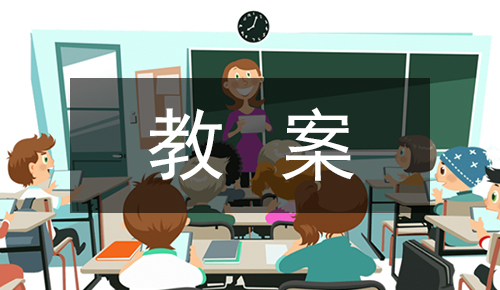
1. Read fables,understand the content of the stories and the implied moral education;
2. Able tounderstand the differences in usage and meaning of some key words and use themcorrectly according to the context;
3. Learn andunderstand the Confucian thought of "benevolence, righteousness,propriety, wisdom and faith" and establish correct moral and values;
4. Be able towrite a clear, structured story review.
Importance:
1. Guide studentsto analyze the deep connotation of moral stories through the comparison ofcharacters words and deeds;
2. Help studentsto express their own opinions and opinions based on real life cases;
3. Instruct thestudents to write a clear and structured story review.
Difficulties:
1. Systematicallyexpress my own opinions and opinions on real life cases in English;
2. Independentlywrite a story review with clear viewpoints and distinct layers.
1. Read thepassage in advance, understand the meaning of the new words and phrases in thetext and understand the content of the article by referring to the context andthe dictionary.
2. Understand theliterary genre of allegory, the concise and incisively language, the simple butexpressive plot, the decorative techniques used and the profound truth of theeducational significance revealed.
Step 1 Learning new words
The teacher showsthe pictures or uses the stick figure to draw the new words or phrases in theteaching text.
Step 2 Reading
Activity 1
1.Look at thethree questions in activity 1 and then read the fable.
① What was the king’s idea for teaching an important lesson to hispeople?
②What was the response from most of the people?
③ What did the young girl think and do when she saw the coins?
2.The teacher asksthe students to sort out the origin, history and result of the story and thenanswer the questions.
3.Finally, ask thestudents to summarize the main idea of the story in one or two sentences.
Teachers canprovide some sentence patterns to help students answer questions:
* The king placed the stone in the road because he…
*Most people… but they…
*The young girl…and…
Suggested answers:
①He put a hugestone in the middle of a road, and watched to see if anyone would move it.
② Most of thepeople just got upset that the stone was in their way.
③ She thought that the money belonged to someone else and thatit should be returned.
Activity 2
1. Get the textdetails.Students worked in pairs to find out the different experiences andreactions of each passerby in the passage, and judged their emotions andattitudes according to the details.
2. Then theycompleted the form of activity 2.The teacher may ask the students to writecomplete sentences and use as many different sentence patterns as possible.Suchas:
*The milkman crashed into the stone, which made him very angry, but he went away from the stone.
*After crashing into the stone, the milkman was angry and then he went away.
*The milkman was very angry about crashing into the stone, but he just went away.
Activity 3
1. Students candiscuss the two questions in action 3.
①What do you think this fable is trying to tell us? Do you think the kingwas wise? Why or why not?
②Can you think of times in your own life when you felt and acted like thegirl or like the other people in the story? Give examples.
2. Teachers canencourage students to express their own unique views and opinions, and expandand develop them appropriately.
Suggested Answers
①The moral of the story is that we should alltake responsibility for our community. I dont think that the king was verywise, however,because no one learned anything from his experiment. The milkman,the woman with her water pot, and the other villagers continued on theirtravels without having changed their attitudes at all. The king did find oneresponsible young girl, but she was already a responsible person before sheencountered the stone in the road.
②There have been times when I have acted responsibly like the girl in thestory. For example, I recently saw some children playing on a dangerousbalcony, and so I warned them it was dangerous and had them go somewhere elseto play. However,often Im more like the milkman in the story because Im verybusy with my own work and worries.
Step 3 Analyzing article structure
Activity 4
1.The teacherbriefly introduces the definition, characteristics and requirements of thestory comment, then asks the students to browse the writing outline in activity4, understand the frame layout of the story comment, and summarizethe main points of each paragraph according to the questions listed.
2.Students shouldhave a group discussion on the questions in different paragraphs, find out theanswers to the questions first, then discuss how to form sentences withdifferent details and what sentence patterns can be used, and list thesesentence patterns.
3.Teachers askdifferent groups to report the answers to the questions and ask them to trydifferent sentence patterns.The teacher added some sentence patterns forstudents to refer to when writing.
Step 4 Writing task
Activity 5
1.Write the firstdraft.Students first review the evaluation criteria in activity 5, and thenindependently complete the draft according to the outline of activity 4, theanswers to the questions listed in the group discussion and report, and thereference sentence pattern.
您可能喜欢的文档
查看更多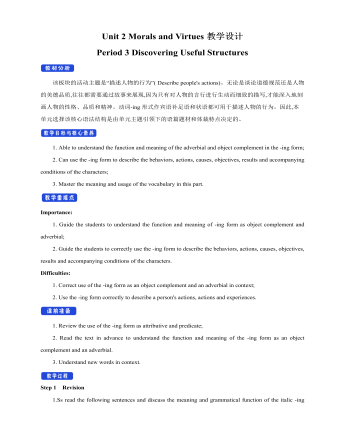
新人教版高中英语必修3Unit 2 Morals and Virtues教学设计三
- 页数:6页
- |大小:82.24KB
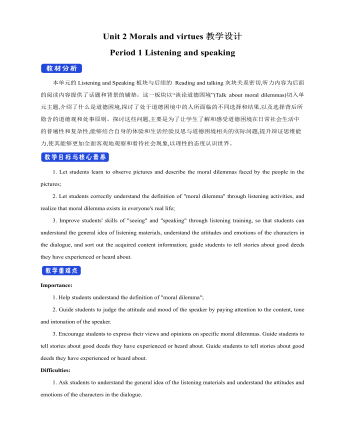
新人教版高中英语必修3Unit 2 Morals and virtues教学设计一
- 页数:7页
- |大小:102.21KB
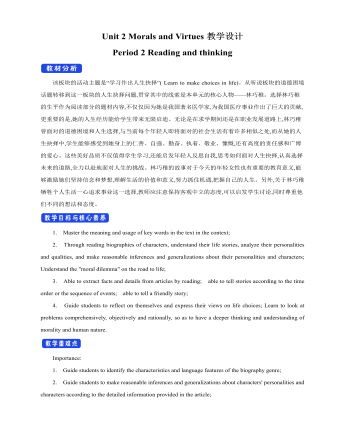
新人教版高中英语必修3Unit 2 Morals and Virtues教学设计二
- 页数:6页
- |大小:282.56KB
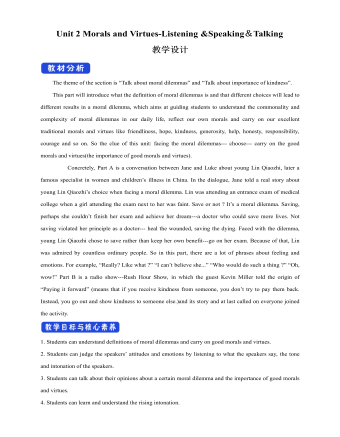
新人教版高中英语必修3Unit 2 Morals and Virtues-Listening &Speaking&Talking教学设计
- 页数:7页
- |大小:309.97KB
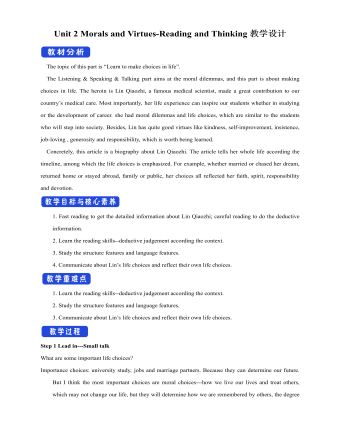
新人教版高中英语必修3Unit 2 Morals and Virtues-Reading and Thinking教学设计
- 页数:5页
- |大小:162.37KB
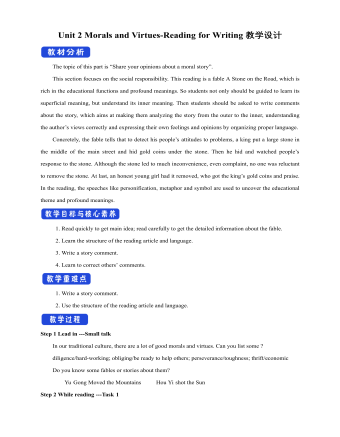
新人教版高中英语必修3Unit 2 Morals and Virtues-Reading for Writing教学设计
- 页数:4页
- |大小:73.70KB
热门课件教案
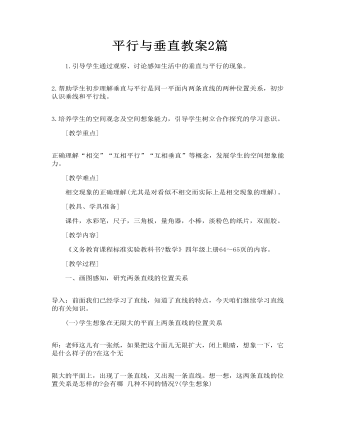
平行与垂直教案2篇
- 页数:9页
- |大小:101.04KB
- 课件教案
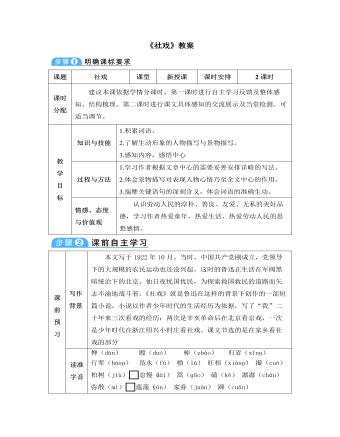
部编版语文八年级下册《社戏》教案
- 页数:8页
- |大小:340.00KB
- 课件教案
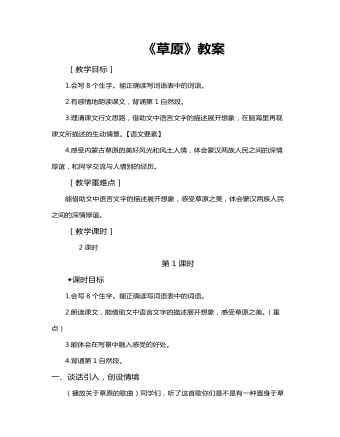
部编版六年级语文上册《草原》教案
- 页数:6页
- |大小:265.86KB
- 课件教案
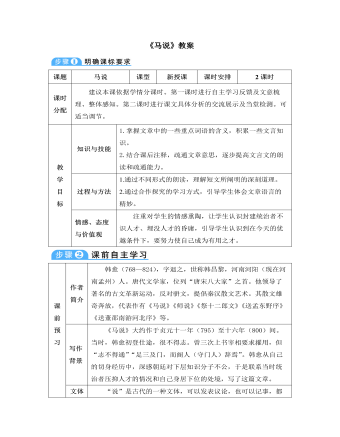
部编版语文八年级下册《马说》教案
- 页数:8页
- |大小:367.50KB
- 课件教案

精选高中生期末评语
- 页数:42页
- |大小:7M
- 课件教案
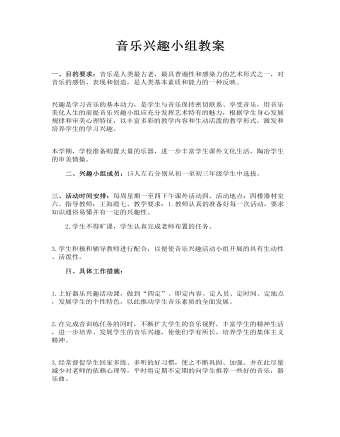
音乐兴趣小组教案
- 页数:5页
- |大小:89.58KB
- 课件教案
今日更新

精选高中生期末评语
- 页数:42页
- |大小:7M

××县招商局2024年上半年工作总结
- 页数:12页
- |大小:142.54KB

“四零”承诺服务创建工作总结
- 页数:5页
- |大小:39.83KB
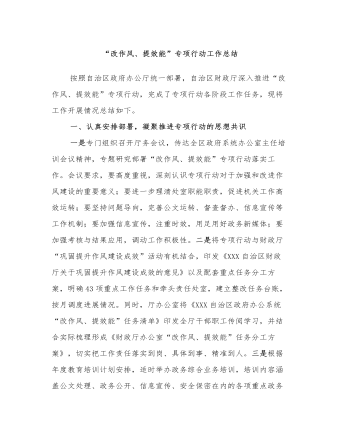
“改作风、提效能”专项行动工作总结
- 页数:6页
- |大小:139.05KB
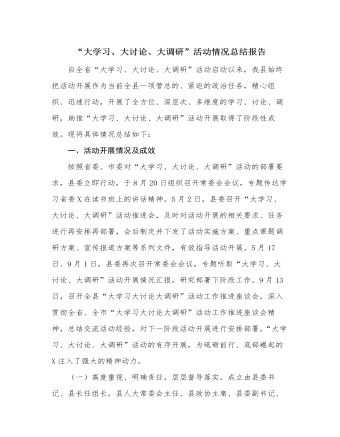
“大学习、大讨论、大调研”活动情况总结报告
- 页数:7页
- |大小:26.12KB
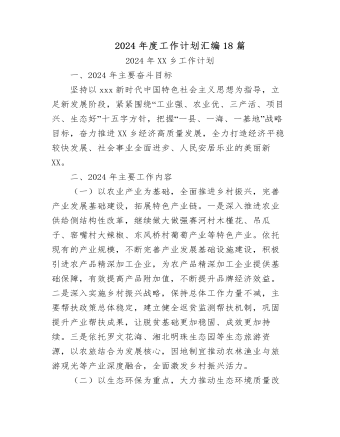
2024年度工作计划汇编(18篇)
- 页数:72页
- |大小:196.93KB






